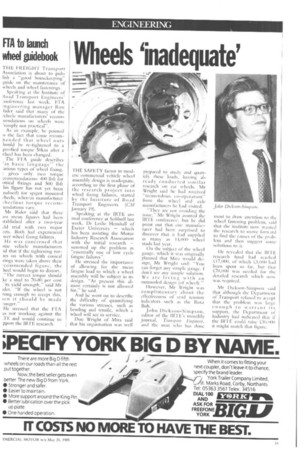Wheels 'inadequate'
Page 17

If you've noticed an error in this article please click here to report it so we can fix it.
"I'HE SAFETY factor in modem commercial vehicle wheel assembly design is inadequate, according to the first phase of the research project into wheel fixing failures, started by the Institute of Road Transport Engineers (CM January 19).
Speaking at the IRTE annual conference at Solihull last week, Dr Leslie Henshall of Exeter University — which has been assisting the Motor Industry Research Association with the initial research — summed up the problem as "essentially one 01 low cycle fatigue failures".
He stressed the importance of allowing for the mean fatigue load to which a wheel assembly will be subject in its design. "At present this almost certainly is not allowed for," he said.
And he went on to describe the difficulty of quantifying the various stresses, such as bending and tensile, which a wheel will see in service.
Don Wright of Mira said that his organisation was well prepared to study and quantify these loads, having already conducted similar research on car wheels. Mr Wright said he had received '`tremendous co-operation' from the wheel and axle manufacturers he had visited.
"They are not avoiding the issue," Mr Wright assured the IRTE conference, but he did point out that One manufacturer had been surprised to discover that it had supplied as many as 11,000 wheel studs last year.
On the subject of the wheel gauge, which it was originally planned that Mira would design, Mr Wright said: "You can forget any simple gauge. I don't see any simple solution. We are living with an outmoded design (of wheel)."
However, Mr Wright was complimentary about the effectiveness of stud tension indicators such as the Rota Bolt.
John Dickson-Simpson, editor of the IRTE's monthly journal, Transport brgineer, and the man who has done most to draw attention to the wheel fastening problem, said that the insdtute now wanted the research to move forward to find the causes of the problem and then suggest some solutions to it.
Fie revealed that the IRTE research fund had reached iI7,000, of which i3,000 had been spent so far, but that 00,000 was needed for the detailed research which now was required.
Mr Dickson-Simpson said that although the Department of Transport rchised to accept that the problem was large enough to warrant its support, the Department of Industry had indicated that if the IRTE could raise V:30,ion it might match that figure.












































































































